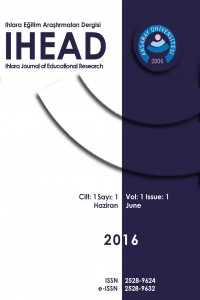THE USE OF PROBLEM-SOLVING TECHNIQUES TO DEVELOP SEMIOTIC PROCEDURAL KNOWLEDGE MODELS ABOUT MAGNETISM AND THEIR ROLE IN LEARNING FOR PROSPECTIVE SCIENCE TEACHERS
Öz
This
study identifies prospective science teachers’ knowledge and achievement levels
in terms of the variables affecting their problem-solving techniques. The aim
is to develop a semiotic procedural knowledge model that will enable them to
better understand complex subjects, such as magnetism. The model was
established by generalizing the nodes from a semiotic model developed for
multiple questions. Assessment and control mechanisms for learning systems were
used in the model to maximize the production quality and efficiency of the
prospective science teachers’ functional behaviors. The data for this study
were collected through four measurement tools. The data were analyzed using
VDOIHI scoring, and the knowledge and achievement levels were identified. The
development of the semiotic procedural knowledge model was based on these
knowledge and achievement levels. Results suggest that semiotic models are
needed for improving the knowledge processes of prospective science teachers.
Anahtar Kelimeler
Procedural knowledge; knowledge level; achievement level semiotic model semiotic procedural knowledge level
Kaynakça
- Andre, T. and Ding, P. (1991). Student misconceptions, declarative knowledge, stimulus condtions and problem solving in basic electricity, Contemporary Educational Psychology, 16(4), 303-313.
- Dacin, P. A. and Mitchell, A. A. (1986). The measurement of declarative knowledge, Advances in Consumer Research, 13, 454-459.
- Drummond, S. R., Hernandez, G., Velez, M. and Villagran, G. (1998). Cooperative learning and the appropriation of procedural knowledge by primary school children, Learning and Instruction, 8(1), 37-61.
- Epstein, H.T. (1986). Stage in human brain development, Developmental Brain Research, 30(1), 114-119.
- Howe, C., Tolmie, A., Tanner, V. D. and Rattray, C. (2000). Hypothesis testing in science: group consensus and the acquisition of conceptual and procedural knowledge, Learning and Instruction, 10(4), 361-391.
- Hudspeth, W.J. and Pribram, K.H. (1990). Stages of brain and cognitive maturation, Journal of Educational Psychology, 82(4), 881-884.
- Johnson, B. R. and Star, J. R. (2007). Does comaring solution methods facilitate conceptual and procedural knowledge? an experimental study on learning to solve equations, Journal of Educational Psychology, 99(3), 561-574.
- Kamouri, A. L., Kamouri, J. and Smith, K. H. (1986). Training by exploration: facilitating the transfer of procedural knowledge through analogical reasoning, International Journal of Man-Machine Studies, 24(2), 171-192.
- Kırkhart, M. W. (2001). The nature of declarative and nondeclarative knowledge for ımplicit and explict learning, The Journal of General Psychology, 128(4), 447-461.
- Lawson, A. E., Alkhoury, S., Benford, R., Clark, B.R. and Falconer, K.A. (2000). What kinds of scientific concepts exist? Concept construction and intellectual development in college biology, Journal of Research in Science Teachin, 37(9), 996-1018.
- Özenli, S. (1999). İlmi sohbetler. Adana: Karakuşlar Otomotiv Tic. ve San. Ltd. Şti., B2.
- Runco, M. A. and Chand, I. (1995). Cognition and creativity, Educational Psychology, 7(3), 243-267.
- Thatcher, R.W., Walker, R.A. and Guidice, S. (1987). Human cerebral hemispheres develop at different rates and ages, Science, 236, 1110-1113.
- Willingham, D. B., Nissen, M. J. and Bullemer, P. (1989). On the development of procedural knowledge, Journal of Experimental Psychology, 15(6), 1047-1060.
- Yılmaz, İ. (2011). Fen bilgisi öğretmen adaylarının Newton’un hareket yasalarını öğrenmelerinde kurallı bilgiden açıklayıcı bilgiye geçişte karşılaştıkları problemlerin incelenmesi (Unpublished doctor’s thesis). Gazi Universitesi, Eğitim Bilimleri Enstitüsü, Ankara (2011), 414012. http://tez2.yok.gov.tr/.
- Yılmaz, İ. and Yalçın, N. (2011). Probability and possibility calculation statistics for data variables (VDOİHİ); statistical methods for combined stage percentage calculation, International Online Journal of Educational Sciences, 3(3), 957-979.
- Yılmaz, İ. and Yalçın, N. (2012a). The Relationship of Procedural and Declarative Knowledge of Science Teacher Candidates in Newton’s Laws of Motion to Understanding, American International Journal of Contemporary Research, 2(3), 50-56.
- Yılmaz, İ. and Yalçın, N. (2012b). Prospective Science Teachers’ Procedural Knowledge about and Knowledge Control in Newton’s Laws of Motion, Sakarya Üniversitesi Eğitim Fakültesi Dergisi (SUJEF), 23, 74-99.
- Yılmaz, İ. and Yalçın, N. (2012c). The effect of Prospective Science Teachers’ Achievement Levels in Procedures and Mathematical Logic Knowledge on their Declarative Knowledge about Newton’s Laws of Motion, Sakarya Üniversitesi Eğitim Fakültesi Dergisi (SUJEF), 23, 121-140.
Ayrıntılar
| Yazarlar | |
|---|---|
| Yayımlanma Tarihi | 30 Haziran 2016 |
| Gönderilme Tarihi | 18 Şubat 2017 |
| Yayımlandığı Sayı | Yıl 2016 Cilt: 1 Sayı: 1 |
IHEAD'ın son sayısının (Cilt 10-Sayı 1) yayımlandığını bildirmekten mutluluk duymaktayız. Sayının yayımlanmasında emeği geçen editör kurulu üyelerine, hakemlere ve yazarlara değerli katkılarından dolayı özel teşekkürlerimizi sunarız. Ayrıca, IHEAD'ın gelecek sayısını (Cilt 10-Sayı 2) Aralık 2025 itibariyle yayımlamayı planlamaktayız. Ocak 2024 tarihinden itibaren dergimize Türkçe makalelerin yanı sıra İngilizce makaleler de kabul etmekteyiz. Eğitimle ile ilgili makalelerinizi değerlendirmekten büyük bir memnuniyet duyacağımızı bildirir katkılarınız için şimdiden teşekkür ederiz.
Editör Kurulu



